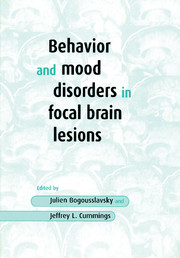Book contents
- Frontmatter
- Dedication
- Contents
- List of contributors
- Preface
- Acknowledgments
- 1 Emotional consequences of focal brain lesions: an overview
- 2 The evaluation of mood and behavior in patients with focal brain lesions
- 3 Methodological issues in studying secondary mood disorders
- 4 Emotional behavior in acute brain lesions
- 5 Depression and lesion location in stroke
- 6 Mood and behavior in disorders of the basal ganglia
- 7 Mania and manic-like disorders
- 8 Behavioral and emotional changes after focal frontal lobe damage
- 9 Disorders of motivation
- 10 Thalamic behavioral syndromes
- 11 Obsessive-compulsive disorders in association with focal brain lesions
- 12 Emotional dysprosody and similar dysfunctions
- 13 Temporal lobe behavioral syndromes
- 14 Neural correlates of violent behavior
- 15 Focal lesions and psychosis
- 16 Alterations in sexual behavior following focal brain injury
- 17 Anosognosia
- 18 Acute confusional states and delirium
- Index
12 - Emotional dysprosody and similar dysfunctions
Published online by Cambridge University Press: 05 August 2016
- Frontmatter
- Dedication
- Contents
- List of contributors
- Preface
- Acknowledgments
- 1 Emotional consequences of focal brain lesions: an overview
- 2 The evaluation of mood and behavior in patients with focal brain lesions
- 3 Methodological issues in studying secondary mood disorders
- 4 Emotional behavior in acute brain lesions
- 5 Depression and lesion location in stroke
- 6 Mood and behavior in disorders of the basal ganglia
- 7 Mania and manic-like disorders
- 8 Behavioral and emotional changes after focal frontal lobe damage
- 9 Disorders of motivation
- 10 Thalamic behavioral syndromes
- 11 Obsessive-compulsive disorders in association with focal brain lesions
- 12 Emotional dysprosody and similar dysfunctions
- 13 Temporal lobe behavioral syndromes
- 14 Neural correlates of violent behavior
- 15 Focal lesions and psychosis
- 16 Alterations in sexual behavior following focal brain injury
- 17 Anosognosia
- 18 Acute confusional states and delirium
- Index
Summary
Introduction
The importance of intonation meanings is generally well understood. However, until recently, relatively little attention has been paid to prosodic deficits following focal brain damage. In the nineteenth century, Hughlings Jackson (1874, 1915) described preserved singing and emotional speech in aphasia, thought to be ‘duplicated' in the right hemisphere. The American neurologist Mill (1912) spoke of the 'zone of emotion and emotional expression as especially developed in the right cerebral hemisphere,’ referencing facial and behavioral but not vocal examples (p. 167). Critchley (1964) noted expletives and other emotive expressions as residual aphasic speech. The first focused investigation was Monrad-Krohn's (1947) now famous description of a selective ‘melody of speech’ disorder, but the deficit was linguistic (see Moen, 1991) and did not involve ‘emotional prosody’ (Monrad- Krohn, 1963). Except for these few important efforts, more interest over the past century has been devoted to the related topics of facial emotional expression and the experience of emotion, until the inception in 1975 of emotional prosody studies in patients with brain lesions.
Despite the obvious correspondences between facial and vocal emotional expression, and some findings of impairments in common (Cancelliere and Kertesz, 1990), the extent to which they share processors in the adult brain is unclear (Starkstein et al, 1994; Hornak, Rolls, and Wade, 1996; Stone et al., 1996). Bowers et al. (1996) as well as Breitenstein, Daum, and Ackermann (1998), recently reported a double dissociation between the identification of facial and vocal emotional expressions, suggesting independence of these functions. In the child, the ability to judge the emotional meaning in facial expression develops significantly earlier than the ability to correctly identify vocal emotions (Brosgole and Weisman, 1995). This chapter does not attempt to resolve the relationship between emotional expression in the two modalities (with gesture as a third), but instead focuses on the effects of brain lesions on vocal emotional processing in adults.
Emotions research can be broadly cast into three components: emotional behavior (e.g., autonomic responses, overt behavior), emotional feelings/experiences (subjective reports), and the communication of emotion through tone of voice (prosody), facial expressions, and gestures (Heilman, 1997). Benson (1984) uses the term ‘mood’ to refer to a ‘subjective feeling tone,’ with the term ‘affect’ referring to ‘the observable physical manifestations of emotion,’ adding the notions ‘drive’ and ‘motivation’ to ‘characterize the energy of emotions’ (Benson, 1996, p. 91).
- Type
- Chapter
- Information
- Behavior and Mood Disorders in Focal Brain Lesions , pp. 327 - 368Publisher: Cambridge University PressPrint publication year: 2000



